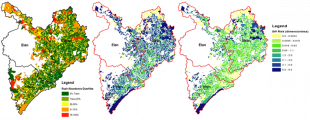Last week ( 5 October) the Defra Earth Observation Centre of Excellence (EO-CoE) held its first innovation workshop. This event was a direct follow up from the high priority areas identified at the Earth Observation and Open Data Showcase that took place in Nobel House in February.

The workshop consisted of policy and technical presentations followed by three breakout sessions where attendees looked at challenges and opportunities of applying remote sensed data to their operational activities. Around 30 people from Defra, industry and academia took part in the workshop.
The hot topics
There was an esteemed line up of Defra speakers that set up the context for the day including an opening presentation from Nicola Spence, Chief Plant Health Officer. Current policy challenges included:
- Detecting Asian long horn beetles
- Sweet Chestnut distribution
- Understanding Wildlife populations
- Vector spread predictions
Industry and academia presented on the latest EO developments in animal and plant health, including:
- Mapping of tree species, crops and invasive species
- Crop and tree health and stress analysis
- Habitat mapping and risk analysis
- New imaging techniques, modelling techniques and sensor technology
Common themes
In the concluding session of the workshop the group identified broadly two main opportunities: the creation and use of common datasets, and contingency planning and emergency response scenarios. The Defra EO CoE is already critical in leading the progress on cross-cutting applications and collaborative dataset creation especially where there is no lead department or agency and it will be further exploring the requirements that came out of the day.
What next?
The EO-CoE is planning how to respond to the needs identified during the various sessions, especially in relation to common datasets and emergency response scenarios. The EO CoE and the plant and animal health community are to discuss and agree a joint programme of work and the way forward.
What to know more?
If you want to know more about the work of the EO CoE please read our EO Roadmap and look out for further blogs on future events.
